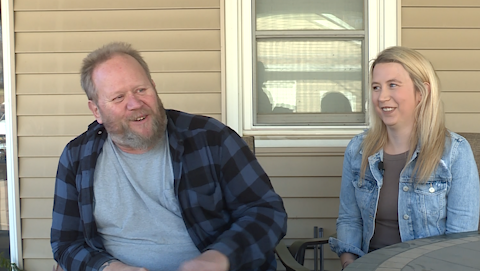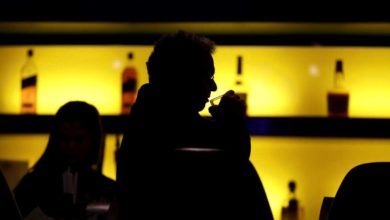
MICHELLE: DOCTORS REMOVED GREG FROST FROM THAT VENTILATOR A YEAR AGO THIS WE. WE FOLLOWED THE JOURNEY OF TSHI COVID AND VENTILATORUR SVIVOR, WHO IS NOW BACK TO WORK FULL TIME. BUT FROST TELLS ME, HE IS FAR FROM BEING BACK TO NORMAL. >> MY FAMILY, ALL MY FRIEN,DS COWORKERS, THEY ALL LOOK AT ME AND SAY, "YOU’RE A WALKING MIRACL"E. MICHELLE: ONE YEAR AGO, GREG FROST COULDN’T WALK. HE WAS LEARNING HOW TO BREATHE ON HIS OWN AGAIN, AFTER BEING IN A MEDICALLY INDUCED COMA AND ON A VENTILATOR FOR FOUR WES.EK >> IT’S BEEN A STRUGGLE, GAINING MY STRENGTH, AND STUFF LIKE THAT. MICHELLE: RECOVERY FOR THE 55-YEAR-OLD MUD PLANT WORKER HASN’T BEEN EASY. >> HE CAME HOME IN A WHEELCHAIR, AND HE NEEDED HELP WITH BASICALLY EVERYTHING, AND NOW HE’S BACK TO 99%. MICHELLE: FROST AND HIS FAMILY HAVE LEARNED HOW TO CELEBRATE THE SMALL VICTORIES, LIKE BEING ABLE TO TIE HIS OWN SHS.OE >> NOT GNAON BE A QUITTER, CAN’T DO THAT. ANYBODY CAN QUIT. IT TAKES TIME TO CLIMB THE MOTAUNIN TO GET TO THE T. MICHELLE: PULMONOLOGISTS SAY THAT CLIMB CAN BE SLOW AND CAN TAKE YEARS. TYPICALLY ONE DAY ON A VENTILATOR MEANS ONE WEEK OF RE HABILITATION. >> IT’S A MUCH LONGER TIME YOU ARE FIGHITNG FOR YOUR LI, ATFE TIME, THAT DURATION EXHAUSTS THE BODY, YOU HAVE NO RESERVE LEFT. IT REALLY DOES MEAK A BIG IMPACT MONTHS, YEARS DOWN THE ROAD. MICHELLE: DR. DANIEL HERSCHBERGER SAYS THE CHANCE OF SURVIVAL AFTER BEING ON LIFE SUPPORT IS 50-50. OSFRT THOUGHT HE WAS GOING TO BE THE OTHER STATISTIC. >> WHEN YOU SEE THE LIG,HT YOU CAN GO TO THE LIGHT. I’VE SEEN IT, BUT I JTUS COULDN’T GET UP AND GO. >> IT WAS NOT CLOSE. IT MAKES YOU WONR,DE LIKE, SOMETHING WAS HOLDING HIM BACK, KELI ALL OF US HERE. THAT’S WHAT HE IS STILL WITH US TODAY. MICHLE:EL NOW HE’S BACK TO WORK FULL ANDPP ARECIATES HIS FAMILY AND ADMITS IT’S ALSO BEEN MENTALLY TOUGHBU, T HE KNOWS HE’S A SURVIVOR. >> SOME DAYS ARE -- IT CAN BE VERY, VERY DIFFICULT, BUT AS LONG AS I WAKE UP ANOTHER DAY -- WAKE UP EVERYDAY, IT IS ANOTHER ODGO DAY. MICHELLE: DR. HERSCHBERGER SAYS THEY ARE PUTTING MUCH YOUNGER PEOPLE THAN FROST ON VEILNTATORS, WHO ARE UNVACCINAT.ED FROST SAYS THERE WAS NO VACCINE AVAILABLE FOR HIM WHEN GOT -- WHEHEN GOT COVID, AND DOESN’T UNDERSTAND WHY PEOPLE WOULD TAKE THE CHANCE OF
'Walking miracle': Father appreciates life after surviving COVID-19, being on ventilator for 4 weeks
Doctors removed the ventilator from Greg Frost one year ago. He's still recovering.
Doctors removed Greg Frost from that ventilator a year ago this week, Dec. 6, 2020.Sister station KETV followed the journey of the COVID-19 survivor, who is now back to work full time.But he admits he is far from being back to normal."My family, all my friends, coworkers they all look at me and say, 'You're a walking miracle," Greg Frost said.One year ago, Frost, 55, couldn't walk. He was learning how to breathe on his own again, after being in a medically induced coma and on a ventilator for four weeks. He contracted COVID-19 around Halloween last year. "It's been a struggle, gaining my strength and stuff like that," he said.Recovery for the MUD plant worker hasn't been easy. "He came home in a wheelchair and he needed help with basically everything, and now he's back to 99%," Greg's daughter, Haley Frost, said. Frost and his family have learned how to celebrate the small victories, like being able to tie his own shoes."I'm not gonna be a quitter, anybody can quit. It takes time to climb the mountain, to get to the top," he said.Pulmonologists say that climb can be slow and can take years; typically one day on a ventilator means one week of rehabilitation."It's a much longer time you are fighting for your life," said Dr. Daniel Hershberger with Nebraska Medicine. "With that time, that duration exhausts the body, you have no reserve left. It does make a big impact months, even years down the road."Hershberger said the chance of survival after being on life support is 50-50.Frost thought he was going to be the other statistic."Two guys asked me, 'When you were in that state of mind and put out did you see the light?' and I said, 'Oh yeah, yeah, I seen it,'" Frost said. "You can go to the light. I seen it but I just couldn't get up and go.""It was that close. It makes you wonder if something was holding him back, like all of us here, that's why he's still with us today," Haley Frost said.Now that Frost is back to work full time, he also appreciates time with his family. He also admits it's also been mentally tough, but he knows he's a survivor. "Some days can be very, very difficult, but as long as I wake up another day, it's a very good day," he said. Hershberger said they are putting much younger people than Frost on ventilators, who are unvaccinated.Frost said there was no vaccine available for him when he got COVID-19 and doesn't understand why people would take the chance of ending up on life support."It's a free country, you can do what you want, but look at the alternative and what can happen to you. It will take your life if it gets bad enough, that's for sure," Frost said.
Doctors removed Greg Frost from that ventilator a year ago this week, Dec. 6, 2020.
Sister station KETV followed the journey of the COVID-19 survivor, who is now back to work full time.
But he admits he is far from being back to normal.
"My family, all my friends, coworkers they all look at me and say, 'You're a walking miracle," Greg Frost said.
One year ago, Frost, 55, couldn't walk. He was learning how to breathe on his own again, after being in a medically induced coma and on a ventilator for four weeks. He contracted COVID-19 around Halloween last year.
"It's been a struggle, gaining my strength and stuff like that," he said.
Recovery for the MUD plant worker hasn't been easy.
"He came home in a wheelchair and he needed help with basically everything, and now he's back to 99%," Greg's daughter, Haley Frost, said.
Frost and his family have learned how to celebrate the small victories, like being able to tie his own shoes.
"I'm not gonna be a quitter, anybody can quit. It takes time to climb the mountain, to get to the top," he said.
Pulmonologists say that climb can be slow and can take years; typically one day on a ventilator means one week of rehabilitation.
"It's a much longer time you are fighting for your life," said Dr. Daniel Hershberger with Nebraska Medicine. "With that time, that duration exhausts the body, you have no reserve left. It does make a big impact months, even years down the road."
Hershberger said the chance of survival after being on life support is 50-50.
Frost thought he was going to be the other statistic.
"Two guys asked me, 'When you were in that state of mind and put out did you see the light?' and I said, 'Oh yeah, yeah, I seen it,'" Frost said. "You can go to the light. I seen it but I just couldn't get up and go."
"It was that close. It makes you wonder if something was holding him back, like all of us here, that's why he's still with us today," Haley Frost said.
Now that Frost is back to work full time, he also appreciates time with his family. He also admits it's also been mentally tough, but he knows he's a survivor.
"Some days can be very, very difficult, but as long as I wake up another day, it's a very good day," he said.
Hershberger said they are putting much younger people than Frost on ventilators, who are unvaccinated.
Frost said there was no vaccine available for him when he got COVID-19 and doesn't understand why people would take the chance of ending up on life support.
"It's a free country, you can do what you want, but look at the alternative and what can happen to you. It will take your life if it gets bad enough, that's for sure," Frost said.
Source link







